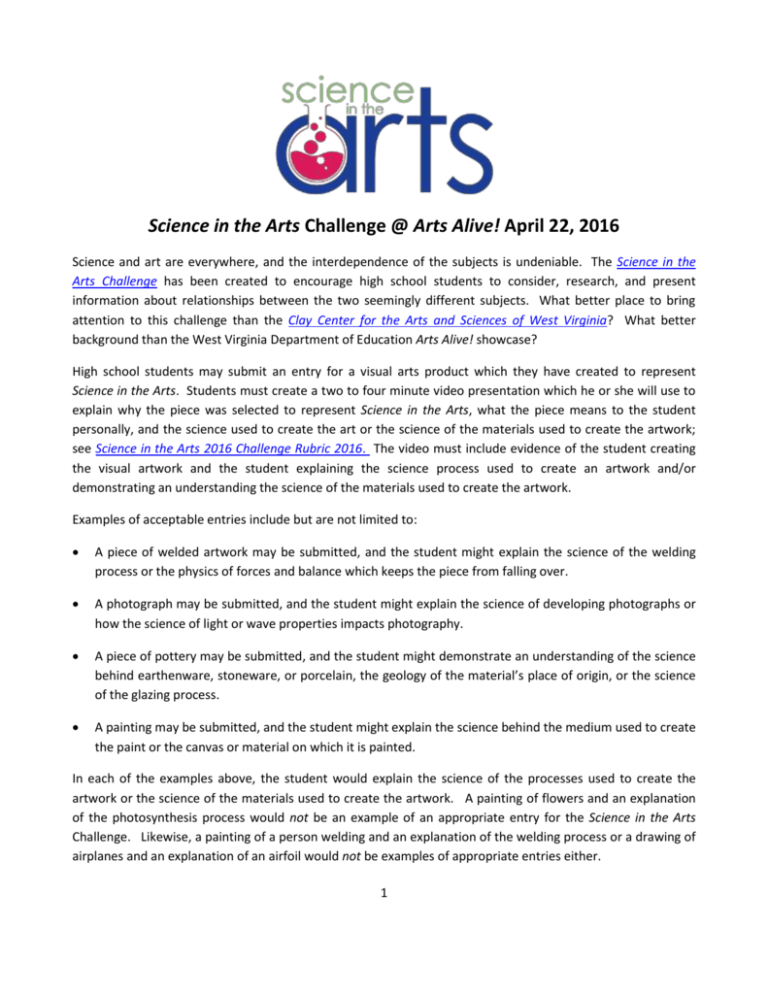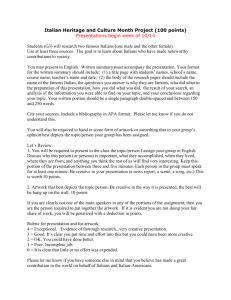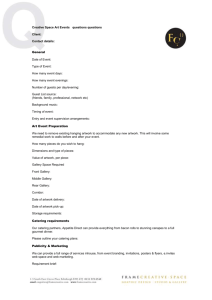Science in the Arts Challenge @ Arts Alive! April 22, 2016 Science
advertisement

Science in the Arts Challenge @ Arts Alive! April 22, 2016 Science and art are everywhere, and the interdependence of the subjects is undeniable. The Science in the Arts Challenge has been created to encourage high school students to consider, research, and present information about relationships between the two seemingly different subjects. What better place to bring attention to this challenge than the Clay Center for the Arts and Sciences of West Virginia? What better background than the West Virginia Department of Education Arts Alive! showcase? High school students may submit an entry for a visual arts product which they have created to represent Science in the Arts. Students must create a two to four minute video presentation which he or she will use to explain why the piece was selected to represent Science in the Arts, what the piece means to the student personally, and the science used to create the art or the science of the materials used to create the artwork; see Science in the Arts 2016 Challenge Rubric 2016. The video must include evidence of the student creating the visual artwork and the student explaining the science process used to create an artwork and/or demonstrating an understanding the science of the materials used to create the artwork. Examples of acceptable entries include but are not limited to: A piece of welded artwork may be submitted, and the student might explain the science of the welding process or the physics of forces and balance which keeps the piece from falling over. A photograph may be submitted, and the student might explain the science of developing photographs or how the science of light or wave properties impacts photography. A piece of pottery may be submitted, and the student might demonstrate an understanding of the science behind earthenware, stoneware, or porcelain, the geology of the material’s place of origin, or the science of the glazing process. A painting may be submitted, and the student might explain the science behind the medium used to create the paint or the canvas or material on which it is painted. In each of the examples above, the student would explain the science of the processes used to create the artwork or the science of the materials used to create the artwork. A painting of flowers and an explanation of the photosynthesis process would not be an example of an appropriate entry for the Science in the Arts Challenge. Likewise, a painting of a person welding and an explanation of the welding process or a drawing of airplanes and an explanation of an airfoil would not be examples of appropriate entries either. 1 The applicant’s name and their school’s name must be clearly spoken within the first thirty (30) seconds of the videos. Videos must be uploaded to YouTube and access to the video must be given the WVDE in the electronic form by Sunday, March 6, 2016. Additionally, an electronic application must be submitted by Sunday, March 6, 2016, as well. Visit this link to complete the electronic application. If participants, parents, or teachers have concerns about who might view YouTube videos, please see WHAT YOU NEED TO KNOW ABOUT YOUTUBE VIDEOS… Artwork will be scored on three criteria1. The Artwork- The focus is on the technique, craftsmanship, originality, and expression of the artwork. 2. The Science- How well does the student demonstrate an understanding of the science processes or materials used to create the work of art? 3. The Video- How well does the student use the video to convey a message and meet the criteria of the rubric? See Science in the Arts 2016 Challenge Rubric. Students are strongly encouraged to use the rubric as they decide what artwork to enter, how to research the science of the artwork, and what to include in their video. Judges may only award points if a criterion for a category is represented in the artwork or video. Teachers are encouraged to assist students in using the rubric. If you have questions about the rubric, please contact Robin Sizemore at robin.sizemore@k12.wv.us . The winner will be contacted by Friday, March 25, and the winning artwork must delivered to the Clay Center in Charleston, West Virginia by noon on Friday, April 22, 2016 so the artwork may be displayed and shown prior to the Arts Alive performances. The video of the winning entry may be shown before and/or during the Arts Alive! Program as well. The prize for the challenge will be awarded during the Arts Alive program. The student is responsible for collecting their artwork after the show. The prize for Science in the Arts 2016 Challenge is $200. A total of 54 points may be earned on the rubric and a minimum of 43 points must be earned for a participant to be awarded first place. The Science in the Arts 2016 Challenge Rubric will be used to score the visual arts piece, science information, and video presentation. The art teacher and the science teacher of the winning student will share a $100 prize to be used to purchase supplies for their classrooms. For video examples of past Science in the Arts winners see Science the Arts: Fused Glass and Science in the Arts DNA. If you have questions about the Science in the Arts 2016 Challenge, please contact WVDE Science Coordinator, Robin Sizemore at robin.sizemore@k12.wv.us. Art Coordinator or Dr. Raymond Lowther at ray.lowther@k12.wv.us. 2







